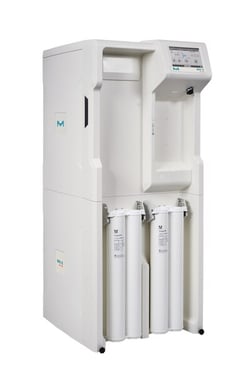
As any clinical lab manager knows, water isn’t just water. Just like the water being used in a facility’s irrigation system is unlike what’s in its water coolers, the water in a facility’s plumbing systems is rarely (rather, never) the water being used in its labs.
Laboratory Water Quality: Are Things Going Swimmingly, or are You Drowning?
In the lab, it’s often all about TOC (total organic carbon) counts in the water (though there are other considerations we’ll dig into as well). Because, no matter what you do, no matter how pure your water may be, there are always some carbon materials in it. The questions today’s lab managers need to answer around TOC are:
- What type of carbon materials are in our lab's water, and how much is in it?
- How do I know if the water in my lab is using is up to our overall standards and is "the right water" for sensitive projects?
Types of Water
Before we dig into how we ensure water quality, let’s explore the types of water most labs typically use, and respective TOC therein: type 1 (ultrapure), type 2, type 3, and type 4.
Type 1 Water
The absolute highest quality (sorry, Evian) and used in analytical labs for critical tasks such as cell and tissue culturing, endeavors where trace carbon elements can wreak havoc on scientific processes.

Milli-Q® IQ 7000 Ultrapure Water Systems
Type 2 Water
Ideal for simpler scientific processes, such as sample dilution and media prep; it can also be “feed water” for a Type 1 system (after further purification).

Milli-Q® HX 7000 Connected, High-Throughput Water Purification Systems
Type 3 Water
Best used for washing lab equipment. It’s usually “plain old tap water” that has been subjected to reverse osmosis.

RiOs™ Essential Water Purification System
Type 4 Water
Also known as tap water and typically feeds water for types 2 and 3. There are myriad products, processes, and systems for “upgrading” Type 4 water (here are just a few).

TOC Analysis: A Constant Need
Ensuring your water is pure comes down to TOC analysis, which is never “one and done.” Filtration systems can sometimes fail, and what you thought was Type 2 is not even Type 3, and contamination occurs.
Monitoring systems absolutely must be in place for every water source required by your lab, as fluctuations in TOC can adversely impact your lab’s environment, your manufacturing process, scientific reproducibility, and even human health.
Fortunately, XiltriX offers an extensive series of tools and monitoring services that provide you with the data you need to help you ensure the quality of your water. And while we can report on TOC levels across every lab-connected water supply, we also monitor for additional issues that could impact your projects and IP.
Beyond TOC
In addition to the types of water detailed above, there’s another type of water that can sometimes show up in the lab: flood water. And, as you may safely assume, the TOC in floodwater is off the charts, and that’s the least of the problems it creates.
With proper monitoring systems in place, however, you can be immediately alerted to any unwanted water flowing into your lab. With proper protocols for preventing lab disasters, continuity of operations planning (COOP), and equipment in place, you can even protect your lab from afar (by remotely shutting off broken valves, for instance).
But even if you’re protected from flooding and have COOP dialed-in, there are still a multitude of issues that can impact water quality, and even availability, such as drops/increases in water pressure, leaks (from equipment or into it), the direction of water flow, pH measurement, and more.
The good news is that for all of the above and more, a service to provide 24/7/365 monitoring of water quality can make a difference between a project that’s moving along fluidly and one that’s struggling to stay afloat.
Take a deep dive into all there is to know about water types for your laboratory in this pdf:
